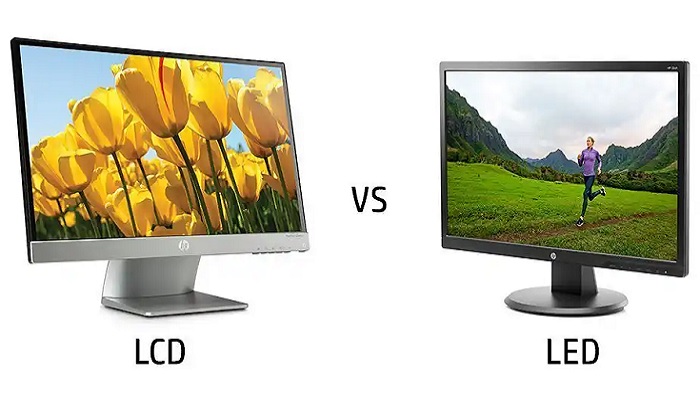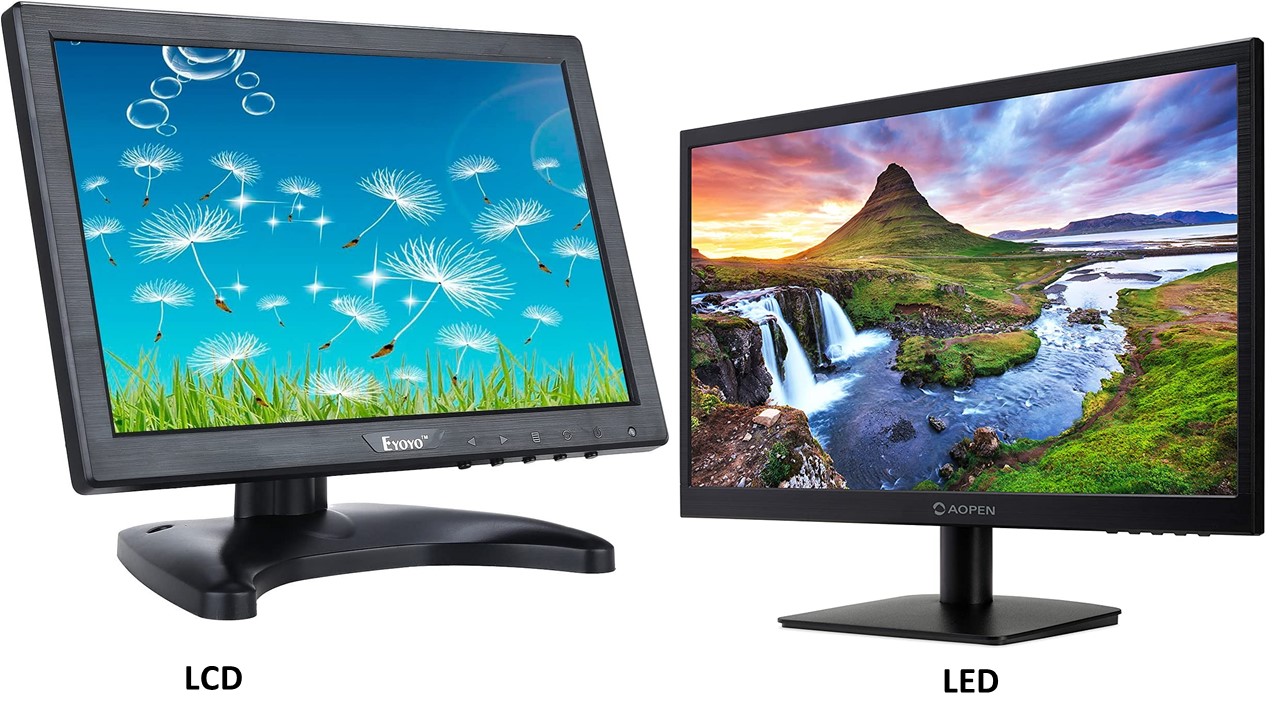From the list of monitor types, the two most common labels are LCD and LED monitors. Well, things can be a bit confusing for any average user to differentiate between an LCD and an LED computer monitor due to the fact that all LED monitors are LCD monitors but the converse is not true.
Apart from the names, there are also other aspects of these two monitors that may be confusing enough for any average user. Well, this article will break them all down for you to make it easier for you to understand.
In This Article
KEY TAKEAWAYS
- In LED monitors Light Emitting Diodes are used for backlighting but LCD monitors use Cold Cathode Fluorescent Lamps.
- The lights in the LED monitors are arranged in zones across the entire screen but in the LCD monitors these are spread evenly behind the screen.
- The quality of light in the LED monitors is much better due to the local dimming feature which is not present in the LCD monitors.
- The LED monitors are long lasting and more energy efficient than the LCD monitors.
The 15 Differences Between LED and LCD Monitors

1. Backlights
Though both these monitors use liquid crystals, in the LED monitors, fluorescent lamps are not used for backlighting.
Instead, very small Light Emitting Diodes are used. It uses two methods namely edge lighting and full-array backlighting.
On the other hand, the backlighting of a standard LCD monitor uses CCFL or Cold Cathode Fluorescent Lamps.
2. Light Arrangements
In the LED monitors, the lights are positioned evenly across the whole screen like in LCD but they are arranged in zones.
On the other hand, in the LCD monitors the CCFLs are evenly spread behind the screen to deliver consistent lighting across.
Therefore, the images have the same brightness levels.
3. Local Dimming
The arrangement of the LEDs allows local dimming that improves the quality of the picture dramatically in high contrast ratio with both very high and very low pixels at the same time.
On the other hand, it is due to the type of the lights and their arrangement in the LCD monitors that does not allow local dimming.
This means that it cannot provide more precise illumination.
4. Life Expectancy
The Light Emitting Diodes themselves last for a long time which enhances the life of the LED monitors on the whole.
On the other hand, the LCD monitors tend to last for a short period of time due to the type of lights used in the units.
5. Energy Efficiency
The LED monitors are much more energy efficient because the Light Emitting Diodes consume much less power.
On the other hand, the LCD monitors are not as energy efficient as the LED monitors because the CCFLs consume a higher amount of power to operate.
6. Design
The design of the LED monitors makes them thinner and much lighter in weight.
On the other hand, the LCD monitors are thicker than and not as lightweight as the LED monitors.
7. Heat
The Light Emitting Diodes do not produce much heat in comparison to the LCDs because it consumes less power to operate.
On the other hand, since the CCFLs of the LCD monitors consume more energy for operation, they produce more heat in comparison to the LED monitors.
8. Response Time
The LED monitors are known to have a much faster response time in comparison.
On the other hand, the LCD monitors usually have a slow response time.
9. Black Level and Contrast Ratio
The black level and contrast ratio of the LED monitors is quite high which results in producing high quality images.
On the other hand, the LCDs do not have as fast a response time or as high response ratio as the LED monitors.
10. Illumination
The illumination of the LED monitors is even and bright all across the screen.
However, in comparison, the LCD monitors offer uneven illumination across the screen.
11. Color Accuracy
The LED monitors will offer much better color accuracy due to its unique features.
On the other hand, the LCD monitors will also deliver good colors but not as accurate as the LED monitors.
12. Viewing Angle
The LED monitors offer a much wider viewing angle but, in comparison, the LCD monitors do not offer such a wide viewing angle.
13. User Comfort
When it comes to user comfort, the LED monitor will be more comfortable to use due to the Light Emitting Diodes that are proven to lessen symptoms of eyestrain.
Also, the wider viewing angle offers more adjustability.
On the other hand, the LCDs may cause some eyestrain and headache due to the constantly bright light emitted from the back of the screen.
14. Affordability
The LED monitors are more expensive than the LCD monitors and therefore may not be affordable for any average computer user.
On the other hand, the cost of production of the LCD monitors have gone down significantly for being in the production for so long which makes it a much more affordable option for everyone to use in their computer than an LED monitor.
15. Environmental Friendliness
The LED monitors are environmentally friendly since the Light Emitting Diodes do not contain any harmful mercury in it.
On the other hand, the LCD monitors come with a pollution cost since they contain mercury in the lights.
Which is Better – LED or LCD Monitor?

Clearly, the LED monitors are far better to use with a computer if you are looking for absolute best picture quality.
It is all due to the different backlight configurations.
Depending on this particular configuration, the quality of the picture may also vary.
For example, the full-array LED monitors offer exceptionally good images than the edge-lit LEDs.
In fact, the LCD monitors can produce even better images than the edge-lit LED monitors.
This means that you cannot ignore the LCD monitors completely.
However, if you play a lot of high-end games on your computer then a full-array LED monitor is the one you should go for.
However, the edge-lit LEDs will be better if you want a clear view from different angles.
On the other hand, if you play the game or use your computer sitting right in front and at the center of the monitor these should not be an issue even if you have an LCD monitor attached with your computer.
This is because it offers even illumination.
Moreover, the even distribution of the lights behind the screen of the LCD monitor reduces glare and therefore offers a wonderful viewing experience, especially in comparison to the edge-lit LED monitors.
More often than not, taking a look at the different pros and cons of the LED monitors and the LCD monitors will help you a great deal in arriving at a decision as to which one of them you would want to use in your computer.
Well, here they are for you.
The list of advantages of the LED monitor includes:
- Energy efficiency
- Thin design
- Light in weight
- Leas heat generation
- Faster response time
- Higher contrast ratio
- More consistent illumination
- No use of mercury
- Backlight dimming option in a few models and
- Longer life span.
As for the downsides of the LED monitors, it includes poor viewing angles from the sides in the edge-lit LED monitors, and also its higher price tag.
However, keep in mind that image retention or screen burn is quite a possibility in the LED monitors which, however, may not be in the case of the LCD monitors.
On the other hand, the downsides of the LCD monitors seem to be much more than the LED monitor and it include:
- Less energy-efficient
- Larger in size
- Thicker in design
- No local dimming support
- Uneven illumination
- Shorter life span and
- Difficulty in maintenance and repairing.
The most significant advantage of the LCD monitors is the lower price in comparison to the LED monitors.
When it comes to using the computer for a long time at a stretch, the LED monitors are much better in comparison to the LCD monitors because, as said earlier, it will not cause eyestrain and headache.
Also, the effect of direct current on an LCD can reduce its life space, which, on the other hand, is not a possibility with the LED monitors.
However, in terms of the actual display area, it is quite smaller in the case of the LED monitors in comparison to the LCD monitors.
So, with all that said and after comparing different aspects of the two types of monitors, it is clear that the LED monitors are the winner hands down in almost all the aspects in comparison to an LCD monitor, apart from the cost and a few other minor ones.
However, the longer life expectancy of the LED monitors will balance its high price in the long run.
Conclusion
So, after reading this article, you now know the difference between the LED and LCD monitors and that the choice of the screen to use is a personal matter and varies on the given conditions and the needs and preferences of the users.
So, you can easily decide which to use with your computer.